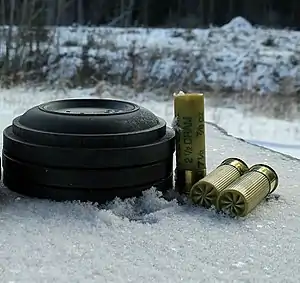20-gauge shotgun
The 20 gauge shotgun, also known as 20 bore, is a type of smoothbore shotgun. 20 gauge shotguns fire a shell with a diameter of .615 in (15.6 mm), while the more common 12 gauge shell has a diameter of .729 in (18.5 mm). It is often used by beginner shooters, or those desiring less recoil than the 12 gauge chambering entails, for target practice and hunting small game.
| 20 gauge | ||||||||||||||||||||||||
|---|---|---|---|---|---|---|---|---|---|---|---|---|---|---|---|---|---|---|---|---|---|---|---|---|
 3 23⁄4" 20 gauge shells (right) loaded with #71⁄2 birdshot. | ||||||||||||||||||||||||
| Type | Shotgun | |||||||||||||||||||||||
| Place of origin | ||||||||||||||||||||||||
| Production history | ||||||||||||||||||||||||
| Manufacturer | Various | |||||||||||||||||||||||
| Variants | 21⁄2" (63.5 mm) 23⁄4" (70 mm) 3" (76.2 mm) | |||||||||||||||||||||||
| Specifications | ||||||||||||||||||||||||
| Case type | Rimmed, straight | |||||||||||||||||||||||
| Bullet diameter | .615 in (15.6 mm) | |||||||||||||||||||||||
| Shoulder diameter | .684 in (17.4 mm) | |||||||||||||||||||||||
| Base diameter | .697 in (17.7 mm) | |||||||||||||||||||||||
| Rim diameter | .766 in (19.5 mm) | |||||||||||||||||||||||
| Rim thickness | .0484 in (1.23 mm) | |||||||||||||||||||||||
| Case length | 2.76 in (70 mm) | |||||||||||||||||||||||
| Primer type | Shotshell Primer | |||||||||||||||||||||||
| Maximum pressure | 12,000 psi (83 MPa)[1] | |||||||||||||||||||||||
| Ballistic performance | ||||||||||||||||||||||||
| ||||||||||||||||||||||||
Description
It takes 20 lead balls of the diameter of a 20 gauge shotgun bore to equal one pound, while it only takes 12 lead balls of the diameter of a 12 gauge shotgun bore to equal the same weight. A 20 gauge shotgun is more suitable for hunting certain types of game or for some hunters because it recoils less, and the guns weigh less and may be smaller.
Regarding the yellow body tube color 20gauge ammunition usually has, it has been reserved in SAAMI documentation saying "SAAMI has reserved yellow for 20 gauge ammunition" "This ammunition shall have a body tube that is primarily yellow" "Yellow shall not be used for any other gauge/bore shotshell body" "No other recommendations are made as to the color of service body tubes for other gauges/bores"[2]
Specifications
20 gauge shotguns are especially suitable for hunting game birds such as quail, grouse and mallards when using lead-free birdshot. A 20 gauge buckshot load would most commonly be utilized in close- to mid-range self defense scenarios. While slug loads are ballistically less accurate than rounds used in rifles, powerful, high-grain slug loads can provide improved ballistics for hunting deer when paired with a rifled barrel.[3]
Performance
A usually lower gun weight makes a 20 gauge appropriate for young, elderly, or less muscular shooters who may have a difficult time carrying, aiming, and firing a larger shotgun, or just don't need a larger gun to hunt their target game. In addition, 20 gauge shotguns generally have less recoil than 10, 12, or 16 gauge versions on average, when comparing standard hunting shells, due to the lower projectile payload. These parameters make the 20-gauge more pleasant to use on extended hunting trips for small game or upland birds, even for people capable of firing magnum-power 12-gauge hunting rounds.
Full-power 20 gauge shells fired from a light 4.5 lb (2.0 kg) gun will have more felt recoil than reduced-recoil 12 gauge shells fired from a heavy 8 lb (3.6 kg) gun.
See also
References
- Saami pressures. (n.d.). Retrieved May 3, 2023, from https://leverguns.com/articles/saami_pressures.htm
- "ANSI/SAAMI Cartridge & Chamber Drawings, 2019-04-23 Shotshell, PDF page 50 MISCELLANEOUS: BODY TUBE COLOR" (PDF).
- Maddox, Brandon (January 22, 2021). "SHOTGUN AMMO TYPES: BUCKSHOT VS. BIRDSHOT VS. SLUG". Silencer Central. Archived from the original on November 7, 2022. Retrieved November 7, 2022.